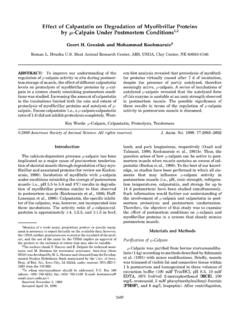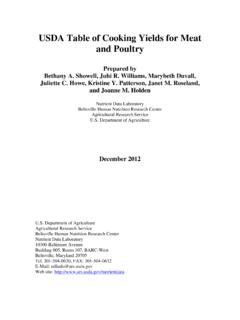Transcription of USDA Nutrient Data Set for Retail Beef Cuts
1 USDA Nutrient Data Set for Retail Beef Cuts Release Prepared by Kristine Y. Patterson, Marybeth L. Duvall, Seema Bhagwat, Juliette C. Howe (Ret.) and Joanne M. Holden Nutrient Data Laboratory (NDL) Agricultural Research Service Department of Agriculture September 2011 Department of Agriculture Agricultural Research Service Beltsville Human Nutrition Research Center Nutrient Data Laboratory 10300 Baltimore Avenue Building 005, Room 107, BARC West Beltsville, Maryland 20705 Tel. 301-504-0646, E-mail: Web site: 1 Supported by the United States Department of Agriculture (59-1235-0-0059), the National Institutes of Health (Y1-HV-8116-14, DK55865), and the National Cattlemen s Beef Association on behalf of the Beef Checkoff. Support for this work was also provided by grants from the NIH to the UNC Clinical Research Unit (DK56350) and the Center for Environmental Health (ES10126) iTable of Contents Purpose ..1 Introduction.
2 1 Methods And Procedures ..2 Selection of Beef Samples ..2 Cooking Procedures ..3 Raw and Cooked Meat Dissection ..4 Compositing ..4 Nutrient Analysis ..5 Table Format ..6 Data Dissemination ..7 References ..7 Acknowledgements ..8 USDA Nutrient Data Set for Retail Beef Cuts, Release ..9 Beef, round, outside round, bottom round (Biceps femoris), steak, trimmed to 0" fat, select ..9 Beef, round, outside round, bottom round (Biceps femoris), steak, trimmed to 0" fat, choice ..10 Beef, round, tip round, roast, trimmed to 0" fat, select ..11 Beef, round, tip round, roast, trimmed to 0" fat, choice ..12 Beef, loin, top sirloin, steak, trimmed to 1/8" fat, select ..13 Beef, loin, top sirloin, steak, trimmed to 1/8" fat, choice ..14 Beef, loin, tenderloin, steak, trimmed to 1/8" fat, select ..15 Beef, loin, tenderloin, steak, trimmed to 1/8" fat, choice ..16 Beef, flank, steak, trimmed to 0" fat, select ..17 Beef, flank, steak, trimmed to 0" fat, choice.
3 18 Beef, loin, tri-tip, roast, trimmed to 0" fat, select ..19 Beef, loin, tri-tip, roast, trimmed to 0" fat, choice ..20 Beef, chuck, shoulder clod, shoulder tender (Teres major), medallion, trimmed to 0" fat, select ..21 Beef, chuck, shoulder clod, shoulder tender (Teres major), medallion, trimmed to 0" fat, choice ..22 Beef, chuck, shoulder clod, top blade (Infraspinatus), steak, trimmed to 0" fat, select ..23 Beef, chuck, shoulder clod, top blade (Infraspinatus), steak, trimmed to 0" fat, choice ..24 Beef, chuck, shoulder top and center (Triceps brachii), steak, trimmed to 0" fat, select ..25 Beef, chuck, shoulder top and center (Triceps brachii), steak, trimmed to 0" fat, choice ..26 Beef, shoulder pot roast, boneless, trimmed to 0 fat, select ..27 Beef, shoulder pot roast, boneless, trimmed to 0 fat, choice ..28 Beef, shoulder steak, boneless, trimmed to 0" fat, select ..29 Beef, shoulder steak, boneless, trimmed to 0" fat, choice.
4 30 Beef, chuck, mock tender steak, boneless, trimmed to 0 fat, select ..31 Beef, chuck, mock tender steak, boneless, trimmed to 0 fat, choice ..32 Beef, brisket, flat half, boneless, trimmed to 0 fat, select ..33 Beef, brisket, flat half, boneless, trimmed to 0 fat, choice ..34 Beef, shoulder top blade steak, boneless, trimmed to 0 fat, select ..35 Beef, shoulder top blade steak, boneless, trimmed to 0 fat, choice ..36 Beef, chuck, under blade center steak, boneless, Denver Cut, trimmed to 0" fat, select ..37 Beef, chuck, under blade center steak, boneless, Denver Cut, trimmed to 0" fat, choice ..38 Beef, short loin, top loin steak, trimmed to 1/8 fat, select ..39 Beef, short loin, top loin steak, trimmed to 1/8 fat, choice ..40 ii Beef, round, top round, steak, trimmed to 1/8 fat, select ..41 Beef, round, top round, steak, trimmed to 1/8 fat, choice ..42 Beef, chuck, short ribs, boneless, trimmed to 0 fat, select.
5 43 Beef, chuck, short ribs, boneless, trimmed to 0 fat, choice ..44 Beef, rib, small end (ribs 10-12), separable lean only, trimmed to 1/8 fat, select ..45 Beef, rib, small end (ribs 10-12), separable lean only, trimmed to 1/8 fat, choice ..46 Appendix A: Analytical A-1 Appendix B: Nutrient content of separable lean meat, raw ..B-1 Appendix C: Proposed Cuts for Mandatory Beef Labeling ..C-1 Mention of trade names, commercial products, or companies in this publication is solely for the purpose of providing specific information and does not imply recommendation or endorsement by the Department of Agriculture over others not mentioned. 1 Purpose This data set provides retailers with a tool to find the most accurate beef Nutrient data for the purpose of on-pack nutrition labeling. This data set focuses on the beef cuts identified by the USDA Food Safety and Inspection Service (FSIS) for nutrition labeling and, in addition, some new Beef Value Cuts.
6 Introduction Since 1990 s, Nutrient composition data for beef products in the USDA National Nutrient database for Standard reference (SR) have been updated regularly. These updates have been important since changes in animal husbandry practices and industry procedures have led to the availability of leaner cuts, as well as the marketing of cuts not previously available. The USDA Nutrient Data Laboratory (NDL) has been involved in three different studies designed to update or expand the data on beef cuts in SR. These studies included the 1/8 Inch Study, the Beef Value Cuts (BVC) Study, and the Beef Nutrient database Improvement In addition to providing current and accurate estimates for the beef data in SR, these new data are also useful for the industry to meet the USDA Food Safety and Inspection Service (FSIS) proposed labeling regulations for fresh, single-ingredient meats. The 1/8 Inch Study was a collaborative research project conducted by USDA NDL, Texas A&M University, and sponsored by the National Cattleman s Beef Association (NCBA) with support from the the Beef Checkoff Program.
7 The objective of this study was to determine the physical characteristics and Nutrient composition of 13 raw and cooked Retail cuts that had been fabricated with fat trim levels representative of current Retail cuts. This study generated analytical data that had not previously been available in SR. The purpose of the BVC Study was to provide information on a new line of single muscle roasts and steaks, fabricated from the outside round, the knuckle, and the chuck shoulder clod. These cuts, introduced into the Retail market in 2001-2002, include the top blade steak (Infraspinatus), shoulder top and center steaks (Triceps brachii), shoulder tender (Teres major), tip center (Rectus femoris), tip side (Vastus lateralis) and bottom round (Biceps femoris). USDA s NDL, in collaboration with NCBA, with support from the Beef Checkoff Program and the University of Wisconsin conducted this study to determine the Nutrient profile of the BVC for inclusion in SR.
8 Since there is no separable fat present in the denuded single muscles of the BVC study, Nutrient values for Separable Lean Only and Separable Lean and Fat are the same. Five of these six major cuts met the USDA definition of lean1. The NDI Phase I Study updated or expanded the Nutrient profile for all of the Retail cuts from the beef The study was conducted by USDA s NDL, NCBA, with support from the Beef Checkoff Program , in collaboration with Colorado State (CSU), Texas A & M (TAMU), and Texas Tech (TTU). These universities were responsible for identifying and obtaining the beef chuck primals at multiple packing plants in accordance with the study s sampling plan, and with the fabrication of these primals into the required cuts. 1 The FSIS definition: The term lean may be used on the labels of meat or poultry products which possess no more than 10% fat, by weight. ( ) 2 These research studies have ensured that the most accurate beef Nutrient data currently available are now included in the National Nutrient database for Standard reference (SR) and will allow all other Nutrient databases that link to the SR to usethe most up-to-date Nutrient data for use in nutrition research and surveillances to comply with FSIS labeling for single ingredient meats.
9 Release of this dataset, a subset of SR data, will provide accurate Nutrient data to vendors and for preparation of on-pack Nutrient labels for various beef cuts including those that are most often marketed in the Retail case. Objective of Research The objective of the research is to develop, update and maintain the food composition values for beef and beef products in the USDA National Nutrient database for Standard reference (SR) and to assure that estimates of Nutrient data are current and accurate. Methods And Procedures Selection of Beef Samples 1/8 Inch Study Carcasses (n=20) were selected from two packing plants, one in the Texas Panhandle and the other in Nebraska. Ten USDA Choice and ten USDA Select, yield grade 2 and 3, carcasses were selected for the study. These carcasses represented the approximate distribution found in the US beef supply according to the National Quality Beef Audit 1998 (Boleman, et al., 1998). All carcasses were shipped to Texas A&M University for fabrication of the following Retail cuts: arm roast, bottom round roast, bottom round steak, brisket flat half, eye of round roast, flank steak, round tip roast, small-end rib steak, tenderloin steak, tri-tip (bottom sirloin butt) roast (boneless and defatted), top loin steak, top round steak, and top sirloin steak.
10 Cuts were assigned randomly to the following external fat trim levels: cm (0 inch trim), cm (1/8 inch trim), or cm (1/4 inch trim). Three of the cuts (flank steak, round tip roast, and tri-tip roast) had no external fat and were assigned to the cm group for both preparations, raw and cooked. Dried muscle surfaces, extending chine bones, minor muscles, and muscle pieces were trimmed from all cuts. All cuts were vacuum packed individually, labeled, and frozen at -23 C for further dissection and cooking. Additional details on fabrication have been previously published (Wahrmund-Wyle, et al., 2000). BVC Study Animal products were obtained from an IBP (Tyson, Inc.) plant near Sioux City, Iowa. This plant draws cattle from a large number of feedlots and has a nationwide product distribution. Twelve carcasses were identified by quality grade (high choice, average choice, and select) with yield grades of 2 or 3. Two carcasses were used for reserves and for training the meat cutting staff.












